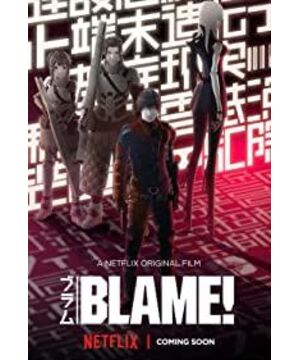Recently, Netflix in the United States bought the copyright of the Japanese doomsday prophecy comic "BLAME" and directly shot it into a drama version of the movie "BLAME!"!
As soon as the shocking worldview of the film came out, it immediately set off a movie viewing craze on the Internet.
Even most non-comic fans are moved by the majestic, decadent and powerless stories inside, with a little life struggling in death.
The network score is currently maintained at a high score of 7.7!
The following only talks about the theatrical version, not the comics. To cover decades of comics in a short 100-minute theatrical version of the story is no easy task, it is simply a dream.
To this end, "BLAME!" wisely chose a very small main story, and will only taste the side stories, so that the audience can understand the tip of the iceberg of the entire BLAME worldview in the conflicting development of the main story.
This time, the attempt to make the BLAME series into film and television was a successful first shot, and it is estimated that the second part and the follow-up will follow soon.
The most amazing part of "BLAME!" is definitely the complete loss of human beings in front of AI under the rampant network + urbanization.
Take a look at the preface of "BLAME!":
MAYBE ON EARTH.MAYBE IN THE FUTURE.
(Maybe on Earth. Maybe in the future.)
The worldview, time view, and values constructed by "BLAME!" are all surreal, hyperspace, overtime.
One day in the future, human beings will be implanted with electronic chips that can communicate with and control cities.
The whole city is fully automated, and humans connect everything through the Internet!
Only one day, humanity was suddenly infected with some unknown virus and lost the ability to connect cities. The scope of the virus has rapidly expanded, and humanity has almost completely lost the ability to link to the central controller.
As a result, the city began to wake up, with self-judgment and cognitive ability.
Humans who have lost the ability to link are judged as "pests" by the city's machine center, the ruling bureau, and the uncertain factors that threaten to disrupt the development of the city need to be eliminated.
So the ruling bureau set up surveillance towers to monitor humans, and created a large number of lethal security guards to hunt and kill humans.
Humanity was suddenly devastated and almost died out in a very short time. Only a handful of human beings stubbornly live in abandoned cities.
Soon, a hundred years later, time has become something forgotten.
The fully automated, self-conscious AI becomes the actual city builder, expanding cities and building new cities on top of them.
The whole world is like a huge, endless tall building. The sky is obscured by superstructures, forming stepped structures that reach thousands of layers.
Thousands of years later, builders have built cities to the orbital plane of Jupiter. The aimless growth of cities has fundamentally led to unmanageable chaos.
The remaining human beings are gradually separated, the population density is gradually reduced, and the human race seems to have lost control of the city forever, and ending this crisis becomes impossible.
The theatrical version of the story happened.
Protected from the slaughter by security guards under mysterious electronic protection, a group of humans living in the Last City, the last city of mankind, has been scraping by for centuries.
The biggest threat to this group of humans is not machines, but the gradual depletion of food.
Young people in the city are forced to go out in search of food. While being chased by security guards, they accidentally run into a mysterious figure with immeasurable abilities, the lone ranger Wuhai.
The group took Wuhai back to the village. He came from a city outside the thousand layers, and the purpose was to find people with pure human genes.
This gene comes from before the infection event. People with this gene can connect to the Internet, control the city, and end the nightmare.
At a time when science and technology were highly developed, human beings had long since gotten rid of the control of time. The implantation of machines and genetic engineering all provided the possibility of prolonging human lifespan. Humans can even machine their brains, and even their souls have been electronic. A spiritual existence that is completely free from the shackles of the human body.
But after being infected, after several generations of reproduction, they finally return to the beginning and become people who need physical support.
Under the old man's memory, they found Hibo, a human scientist who survived during the Judgment Day, in the forbidden place of the city.
Although Hippo is also infected and unable to connect to the Internet, she has invented a machine that can give birth to control genes.
They need to go to the center of the city, build this machine in the factory, inject the genes into the current human beings, so as to connect the network and take back control of the city.
The lingering humans either choose to starve to death here, or choose to go out to be killed by machines, so they choose to go out of their way to help Hippo and the wanderer Wuhai to create control machines to prolong human life.
The story gap is drawn from this, the purpose of the characters is clear, and the conflict between machines and humans constitutes an irreconcilable, life-and-death story tension.
The complete plot is left to the fans to experience by themselves, and the fat brother will not reveal more!
The world view of "BLAME!" covers a very wide range, with the discussion of the human body, shell and soul in "Ghost in the Shell".
The world of "BLAME!" is beyond that of "Ghost in the Shell". Human beings have completely gotten rid of their physical bodies, and even their souls are electronically and their spirits are completely networked.
But it's all built into the machine.
The setting of the story is that one day, this machine awakened, cut off human control over the city, and cut off the human network linking everything.
And, cities began to eat back at humans, treating humans as an "uncertain factor" that creates chaos, a kind of "entropy"-like existence in information theory, and a biologically-like virus-like existence.
In the end, human beings have paid the price of extinction for full-scale networking and full-scale electronicization.
"BLAME!" reflects the anxiety of human beings about machine, technology and network.
It is an extreme counter-evidence to the continuous dependence of human beings on the network, the high trust in machines, and the endless demand for urbanization expansion.
We thought these would lead to a better life for humanity, and as a result, they became the gravediggers of humanity.
The theatrical version of "BLAME!" depicts the decadent beauty of the city under the prosperity of the machine, the sad and melancholy mood of human beings being abandoned by civilization, coupled with the psychedelic music, which highlights the cyberpunk style of the deadly dystopian spirit. The grim city below, the elements of life suppressed by machines pay tribute to "Blade Runner" and many other films of the same type.
The metallic screeching sound of the deadly machine guards' attack, accompanied by the human's cries of fear and the end of life, is the ironic fate of human beings desperately moving towards a fully networked, electronic one.
Behold, we are galloping on the road to destruction, and we are laughing at the bliss of death.
Lose control, surrender soul and body, are we still human?
Since we voluntarily surrendered everything, what is the pity for us to be discontinued, recalled, and eliminated like machines?
In the film, the powerful male protagonist is not so much looking for human genes that can control the city, but rather he is looking for human beings themselves, looking for pure human beings who can control themselves and not be swallowed up by the city and network electrons.
When we lose the connection with nature, the most primitive connection between people, and the memory of human ancestors' "talking about fire at night", we also lose the possibility to control other things and lose the biological chain pyramid The throne in the top position.
View more about Blame! reviews











